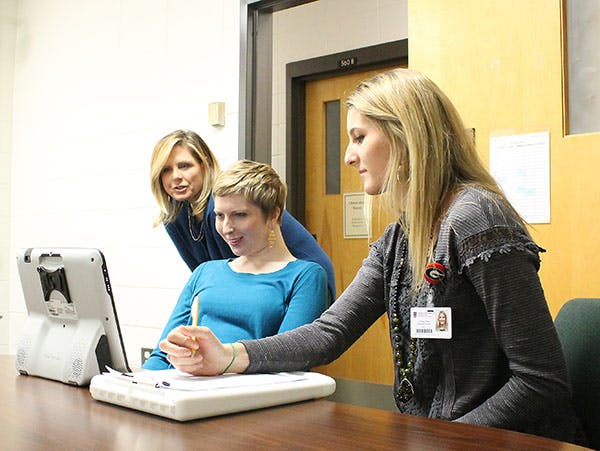Lindsay Price hovered over the small screen set up on the table, waiting for its next cue.
A few touches and beeps later, the computerized speech-generating device was ready to look into the eyes of Price's client, Robbi Van Schoick, and divulge her thoughts.
Price, a master's student studying communication sciences and disorders in the University of Georgia College of Education, wasn't working with a new form of telepathy. Rather, she was learning to set up an augmentative communication device for Van Schoick, who composes emails and other written communication by using her eyes to type out words and sentences on the device's screen.
The specialized device is one of several kinds Price and other students learn to use as part of the College's communication sciences and disorders program. The experience is a key part of their training that isn't found in many programs, said Price's professor, Laura Nichols. The training helps meet a critical need once the UGA students graduate and begin working with patients with complex communication disorders.
 "In a survey done among speech pathologists working in the field, 80 percent reported they did not have adequate training in this specialized area of speech pathology during their graduate programs—and yet almost every one of them has clients using (alternative and augmentative devices) on their caseload," said Nichols, a clinical assistant professor in the College's department of communication sciences and disorders. "Our students get experience with AAC before they are in the working world."
"In a survey done among speech pathologists working in the field, 80 percent reported they did not have adequate training in this specialized area of speech pathology during their graduate programs—and yet almost every one of them has clients using (alternative and augmentative devices) on their caseload," said Nichols, a clinical assistant professor in the College's department of communication sciences and disorders. "Our students get experience with AAC before they are in the working world."
Price said without this training, she would need to rely on product vendors to learn how to set up the special devices, or else search around on the internet for tips.
"Vendors can be helpful, but they don't always know how to take into account the characteristics of a person's disability," added Nichols. "I think our students are in a very good position compared with many other programs, and by having the equipment here in our augmentative communication device lab, they have that hands-on opportunity."
Those capabilities increased recently thanks to the donation of a new, state-of-the-art assistive communication device. The donation was made possible by Deanna and Angie Conley. Deanna recently graduated from the communication sciences and disorders program and her father, Jack Conley, used the device before he died in 2017. Jack was a Gwinnett County police officer who was diagnosed with Lou Gehrig's disease (ALS). Now, his device is getting regular use as part of classes and client interaction.
Working with Van Schoick, Price was able to start up the machine and calibrate it to her client's needs, which involved tracking her eye movements so she could select words on a screen.
Using small movements, Van Schoick, a researcher at UGA who has Friedreich's ataxia, was able to select words she wanted to use to compose a sentence.
"I do need help with communication, but for me, it's much more useful to help me send emails," she said of the device. Van Schoick can speak, but cannot type with her hands because of the disease. "It helps me communicate with friends when not in person."
Price said she appreciated the ability to learn on such high-tech equipment, and it also helped her understand the quality of life it brings to her clients.
For some, like Van Schoick, the technology enhances their work and connections on a professional level. For others, such as another client with autism who is nonverbal, the devices are essential for day-to-day needs. Knowing how to customize the technology is essential, Price added.
"We get to work with many AAC devices, and this one is certainly a unique one," she said. "With the eye gaze technology, it made me rethink how I would develop a session and what I want the client to do, and what's functional for them to communicate."
